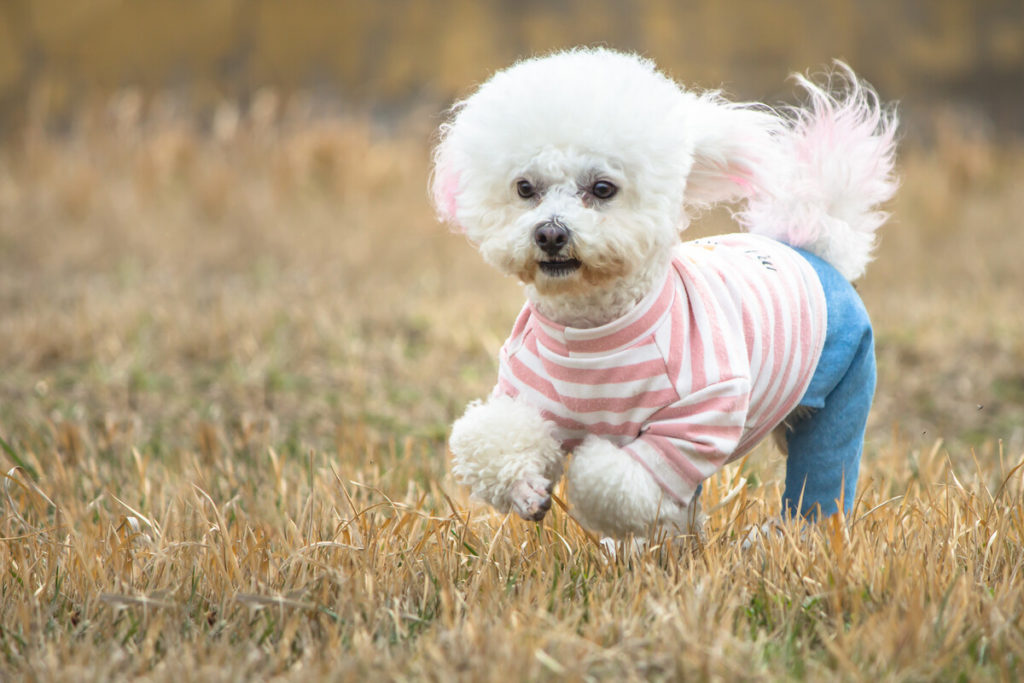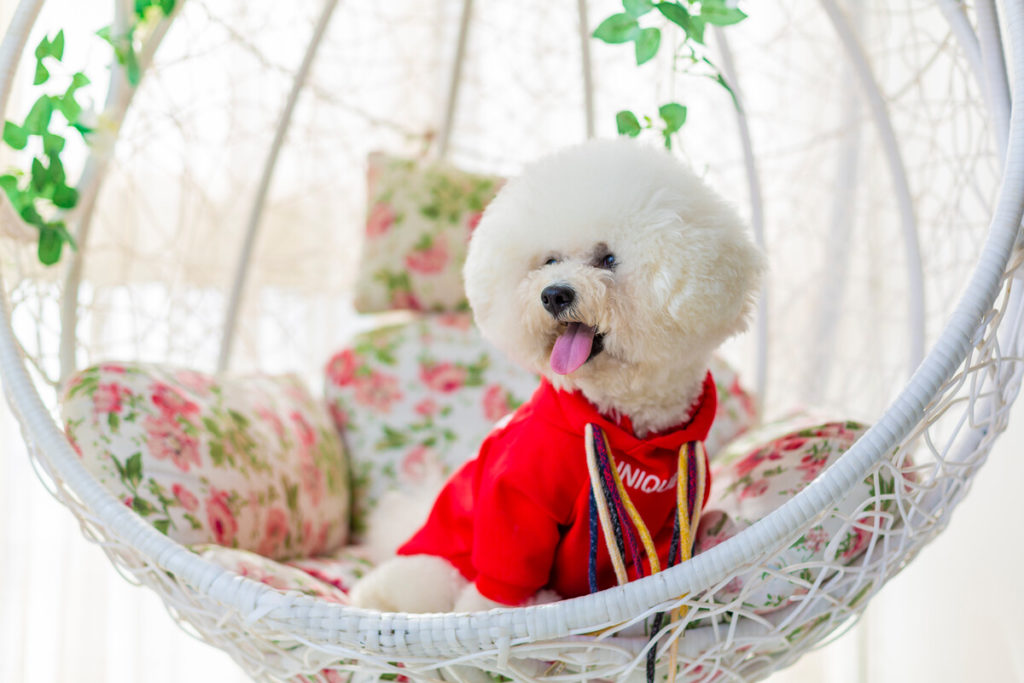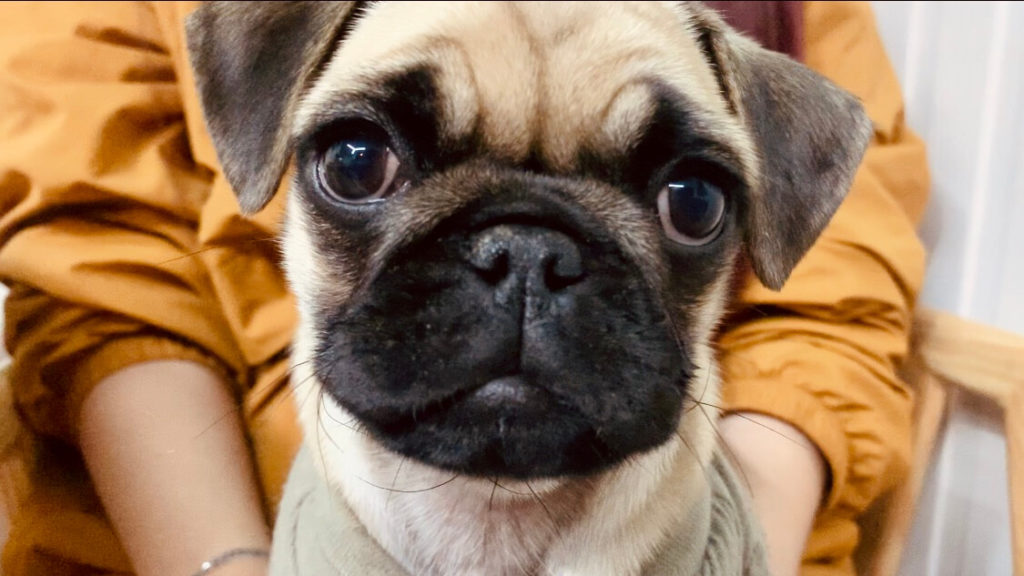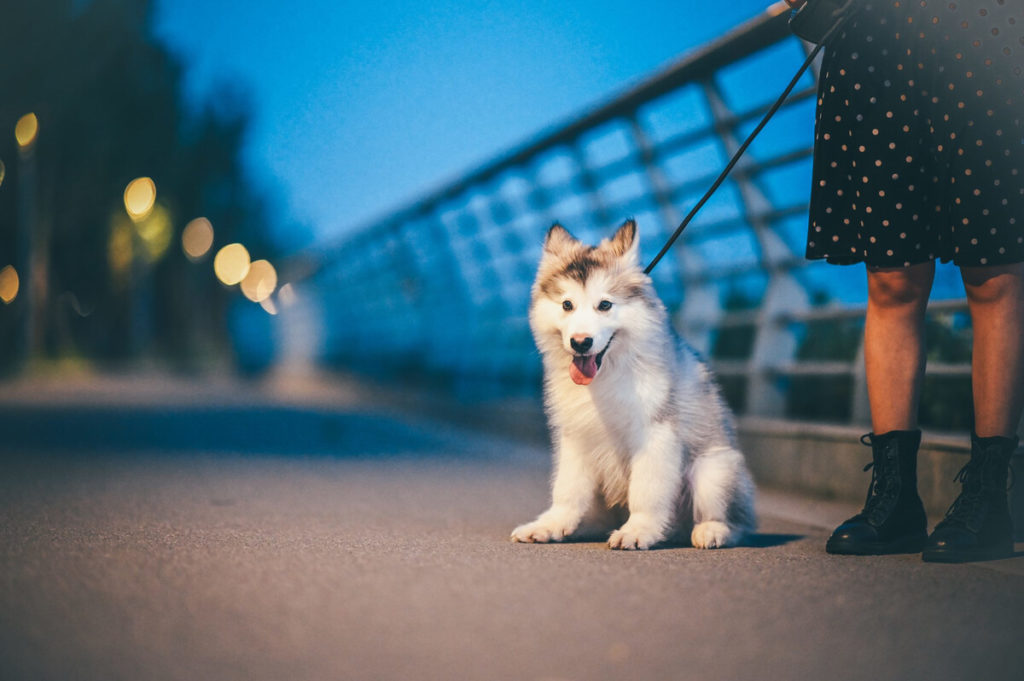Looking for the best toys to get for your Labrador puppy?
The great thing about puppy toys is that if you use them the right way, they can help with:
- Training
- Teething
- Destructive behaviors
- Building a bond with your puppy
- Safe outlets for the endless puppy energy
- And much more
But, that’s only if you use them correctly.

Used incorrectly, they can encourage bad behavior, or worse, be swallowing or choking hazards.
Keep reading to see the best toys to get your Labrador puppy and how to get the most out of them.
Types Of Puppy Toys
Before we get into the best toys for Labrador puppies, let’s first cover the types of toys.
There are essentially four types of toys:
- Chew toys
- Dental Toys
- Interactive Toys
- Plush toys
Each of these types have a specific purpose and benefit, and can help with training in a different way.
Most people don’t have a balance of these types of toys and that can be a problem when they’re thinking about how to train their puppy, how to entertain them, and how to get rid of some of that wild puppy energy.
I’ll share with you my puppy, my dog’s favorites of each type of toy in a second, but besides the types of toys, the other major thing to consider is safety when using them.
How To Use Puppy Toys Safely
The two biggest things to watch out for with toys is your puppy choking on them or swallowing them.
If a toy is swallowed and causes a blockage in their stomach, it’ll probably need to be surgically removed, although it could be fatal, as well as choking on a toy.

So how do you prevent these accidents from happening?
Supervision
Always supervise your puppy with toys, especially if they’re new.
Some toys will be shred apart by your puppy in minutes and there will be lots of little pieces that need to be taken away before they’re swallowed or choked on.
Choosing the right size toy
Labrador puppies aren’t exactly tiny puppies, and they grow quickly.
Make sure that whatever toy you give your puppy is big enough to not get stuck in their mouths or swallowed.
Choosing durable toys
Cheap toys, toys with lots of moving parts, or plush toys are prone to be broken or ripped into smaller pieces.
These are the toys you want to be especially careful with because these smaller pieces can be choking or swallowing hazards.
Talk to your veterinarian for more information about safety and toys.
Alright, now let’s get into the different types of toys.
Chew Toys
Don’t you hate it when you catch your puppy trying to chew up your shoes or some other household item?
Puppies have a natural desire to chew, so it’s not that they’re purposefully trying to destroy your stuff, it’s just that they haven’t learned what’s ok to chew on and what’s not ok.

This is where chew toys come in.
You need to have a rotation of chew toys that serve as safe outlets for your pup to take out their chewing needs.
And in addition to helping satisfy this natural desire to chew, chew toys also help with teething.
Chewing helps relieve the pain and pressure of their adult teeth coming in, and throwing a chew toy in the freezer before you give it to them can also help alleviate teething pain.
Now most chew toys are made of rubber or plastic and the list below has a few different materials to select from.
Nylabone Teething Ring
This was one of my dog’s favorite toys as a puppy.
He would run around the house swinging them, and then when he was tired he would lay down and chew on the keys.
West Paw Rubber Bone
This bone is a favorite and all of West Paw’s toys, in general, are awesome.
The rubber is tough, yet bouncy and has some give, so your puppy will love it.
They’re even dishwasher safe so you can keep it clean for your pup.
Benebone Wishbone
This is one of my dog’s favorite toys to chew.
Plus, since it’s one piece and pretty durable, this is one of the toys we felt confident leaving in his crate with him while unsupervised.
Using Chew Toys For Training
Two of my favorite ways to use chew toys for training are:
- To train puppies to not chew on household items (but chew on chew toys instead)
- To help with crate training
When it comes to teaching your puppy to not chew on household items, here’s what doesn’t really work:
- Yelling at them
- Spraying bad-tasting liquid on items
- Punishing them
Here’s what does work: getting them to want to chew on other things (chew toys) and teaching them not to chew on things besides chew toys.
If you see your puppy chewing on your shoe, interrupt them with a clap or a “Nope!” and then give them an enticing chew toy to chew on (perhaps with peanut butter on it).
Once they start chewing on the chew toy, instead of the shoe, praise them and let them know they’re doing a good job.

Pretty soon when they have the urge to chew they’ll be looking for a chew toy that they know is ok to chew and they like chewing it.
For crate training, durable chew toys are great for keeping them occupied in the crate.
If they’re in the crate stressing about being alone, you’re going to have a tough time getting them comfortable in there.
But if they’re in the crate going to town on a chew toy and loving life, they’ll soon realize the crate is not so bad.
Dental Toys
Dental toys are like fancy chew toys.
They’re durable and made of rubber and plastic, like chew toys, but have knobs and ridges to help clean teeth and massage gums.
Here are some of my dog’s favorite dental toys when he was a puppy:
Kong Dental Stick
The Dental Stick is great because it’s soft and has little pockets for treats or peanut butter.
The ridges in this toy help massage puppy gums and relieve the pain of teething.
Nylabone Dental Bone
The bumps all over this bone help clean your puppy’s teeth and massage their gums, plus it’s made of their softest material specifically made for teething puppies.
Interactive Toys
Interactive toys are toys that let you and your dog play together, such as frisbees, tennis balls, or tug ropes.
They’re great for building a bond with your puppy and for using up their wild puppy energy.
And the cool thing about tug ropes is that they double as dental toys, too, because most dogs love to chew on them and they act like floss with the smaller strands getting in between dogs’ teeth.
Two of my dog’s favorite games are fetch and tug, so tennis balls and tug ropes are his favorite interactive toys.
Tennis Balls
We’ve been using regular Penn tennis balls to play fetch with and they’ve been surprisingly durable (actually more durable than most tennis balls made for dogs).
Tug Rope
When it’s raining outside, or I’m tired of throwing the tennis ball, my dog loves to play tug.
Using Interactive Toys For Training
We already mentioned that interactive toys are great for building a bond with your puppy, but they’re also great for teaching things like drop it and take it, or even sit and down.
To teach drop it with a tug rope you simply stop tugging, hold the rope very still, and wait for your puppy to eventually get bored and let go.
Praise them for dropping it and then after a minute or two of tugging, do it again.
Once your puppy is good at letting go when you stop, you can start saying, “drop it,” when you stop moving.

After enough repetitions of this, they’ll learn to drop it on command.
I also like to reinforce commands like sit and down while playing tug.
I’ll ask my dog to drop it, then ask for a sit or down, then when he obeys, his reward is to resume playing.
This works well because he loves tug, so when I ask him to do something and I’m holding the tug rope, he’s highly motivated to do it.
Plush Toys
Plush toys are soft, fuzzy toys that often have a squeaker inside.
The great thing about these toys is that most puppies love playing with them and will stop nearly anything they’re doing if they hear a squeak.
The bad thing is that they aren’t very durable and those sharp puppy teeth easily rip plush toys apart.
Because they’re not very durable, they need to be played with under supervision because squeakers or pieces of the toy can be ripped off and potentially choked on or swallowed.
And speaking of ripping plush toys, one thing I’ve noticed is that plush toys that are round seem to be more durable than toys that are not.
For instance, the avocado and donuts below have lasted longer than some of my dog’s animal-shaped toys that have ears and tails that are easily ripped off.
With that being said, here are some of my dog’s favorite plush toys.
Zippy Paws Avocado
This squeaky avocado helps my dog feel a little more included when we’re having guacamole.
Zippy Paws Donut
I’m not sure, but I donut think this toy tastes as good as real donuts.
My dog, however, seems to love it.
Squeaky Rubber Pig
Although this pig isn’t plush, it’s soft and squeaky and has given my dog hours and hours of entertainment.
It’s surprisingly durable, but it does get a little slobbery, so it’s not exactly a toy you want to be playing fetch with.
Puzzle Toys
Puzzle toys are another type of toy that can range from chew toys to plush toys.
They’re great at mentally stimulating your pup and are wonderful cures for a bored Labrador.
When you’re thinking about how to use up some of your puppy’s energy (remember this: a tired puppy is a good puppy), you need to think about both physically and mentally stimulating them.
Interactive toys do a great job of physically stimulating them, and puzzle toys (as well as chew toys) are great at mentally stimulating them.
Here are some of the puzzle toys I recommend:
Kong Classic
This is one of the best toys to put in the crate with your puppy since it’s so durable and puppies love them.
I like to put some kibble in a bowl, soak it in water for ten minutes, fill the kong with the soggy kibble, top it off with a dab of peanut butter, then freeze it.
It makes it a lot harder for your pup to get the kibble out and will keep them entertained for a long time.
I always have a few kongs in the freezer at a time just in case I need to do something and my dog needs to be entertained for a bit.
Kong Wobbler
Here’s another toy that will keep your puppy entertained while trying to wobble this toy just right to get it to release some kibble.
If you have an extra hyper puppy, making him earn his meals through training and feeding him strictly through puzzle toys will help curb that limitless energy.
Puppy Toy Mistakes
Although toys are wonderful things, there are definitely some mistakes that people commonly make with them.
Here are a few of them:
Giving your puppy the wrong size toy
We talked about this earlier, but giving your puppy the wrong size toy can be a choking or swallowing hazard if it’s too small.
And if it’s too big, especially with chew toys, it can be too difficult to get a good grip with their mouths to actually enjoy it.
Giving your puppy the wrong toy at the wrong time
For example, chew toys are great for crate training because they’re durable.
However, if you put a hyper puppy in a crate with a plush toy, chances are, the toy won’t last five minutes and it may pose as a choking or swallowing hazard.

Getting cheap toys
Toys are an investment.
We’ve bought way too many toys for my dog that he’s torn up in five minutes.
When picking out toys for your puppy, make sure to do a little research and try to get quality toys, not just the cheapest toys.
This leads us to the next point…
Letting your puppy play with certain toys for too long
If you see that your puppy is in a destructive mood, don’t let her keep the plush toy.
Give her a chew toy instead, otherwise, you’ll be going through a lot of toys…
Letting all toys be available all the time
One of the best tools you can utilize to help your puppy love their toys is a toy bin.
If all toys are available all the time, they lose their novelty.
However, if your puppy only gets to play with their avocado once a week, and their donut once a week, and their pig once a week, then it’s like they’re getting the toy for the first time over and over again!
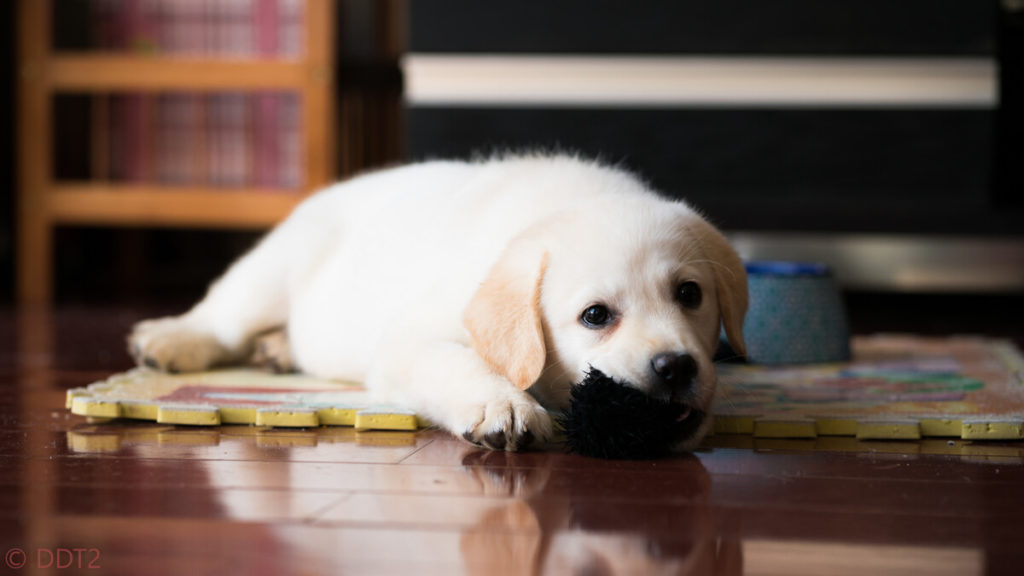
Conclusion
When used correctly, toys are great for training, physical and mental stimulation, and just letting your puppy be a puppy.
Make sure to have a balance of chew toys, dental toys, interactive toys, and plush toys, and always supervise your puppy with them.
Have any questions about toys for Labrador puppies?
Let me know in the comments below!
And if you know someone who has a Labrador puppy, please share this with them!













